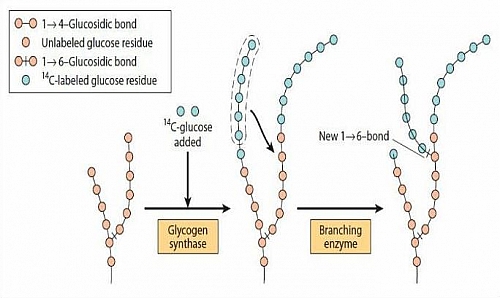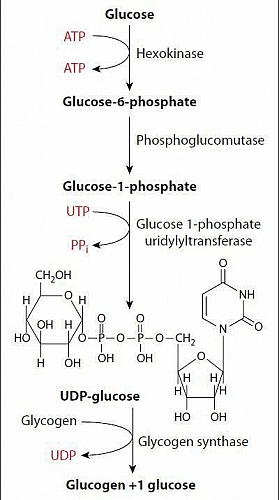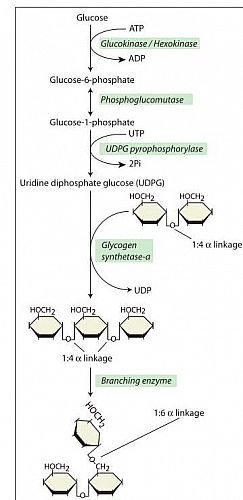Glycogenesis (Glycogen synthesis) is the process through which glycogen is formed from glucose. The glycogenesis pathway involves several specific enzymes that are required to cause these conversions. Sometimes, any monosaccharide that can be converted into glucose can enter into the glycogenesis pathway including some smaller compounds such as lactic acid, glycerol, pyruvic acid, and some deaminated amino acids which are first converted into glucose or closely allied compounds before conversion to glycogen.
Table of Contents
Glycogenesis Definition
Glycogenesis can simply be defined as the formation of glycogen from glucose. In this process, glucose is converted to glucose-6-phosphate by utilizing the terminal phosphate group of ATP. Glucose-6-phosphate is then converted into its somer, glucose-1-phosphate. The final step is carried out by the enzyme glycogen synthase which removes these phosphate groups as it polymerizes glucose to form glycogen.
What is Glycogenesis?
Glycogen synthesis (glycogenesis) occurs during a plentiful glucose supply (fed state). It is stimulated by insulin through its action on glycogen synthase enzyme (this enzyme cannot simply form a bond between two isolated glucose molecules; it must add to an existing chain with alpha (1 : 4) glycosidic linkages), but the process is inhibited by glucagon. The initiation of glycogen synthesis requires a primer for this reason.
Glycogenesis Cycle
Glycogenesis Pathway
- As in Glycolysis, glucose is first phosphorylated to glucose 6-phosphate by the enzyme – hexokinase in muscles and glucokinase in the liver.
- Glucose 6-phosphate is then isomerized to glucose 1-phosphate by phosphoglucomutase. The enzyme itself is phosphorylated, and the phospho-group takes part in a reversible reaction in which glucose 1,6-bisphosphate is an intermediate.
- Glucose-1-phosphate reacts with uridine triphosphate (UTP) to form the active nucleotide uridine diphosphate glucose (UDPGlc) and pyrophosphate. This reaction is catalyzed by UDPGlc–pyrophosphorylase. Pyrophosphatase catalyzes hydrolysis of pyrophosphate to 2 moles of inorganic phosphate thereby shifting the equilibrium of the main reaction by removing one of its products.
- Glycogen synthase then catalyzes the formation of a glycoside bond between C 1 of the activated glucose of UDPGlc and C4 of a terminal glucose residue of glycogen with the liberation of uridine diphosphate (UDP). A preexisting glycogen molecule or glycogen primer, must be present to initiate this reaction. The glycogen primer may in turn be formed on a primer known as glycogenin ( a 37-kDa protein that is glycosylated on a specific tyrosine residue by UDPGlc).
- Further glucose residues are attached in the 14 position to make a short chain that is a substrate for glycogen synthase.
In skeletal muscle, glycogenin remains attached in the center of the glycogen molecule but in the liver, the number of glycogen molecules is greater than the number of glycogenin molecules.
Process of Glycogenesis (Glycogenesis Steps)
- In the first stage of glycogen synthesis, glucose-1-phosphate (obtained from glucose-6-phosphate through isomerization reaction) reacts with Uridine Triphosphate (UTP) to produce Uridine diphosphate glucose (also called UDP-glucose or UDPG) and pyrophosphate (PP i ).
- The addition of UDPG to a growing chain of glycogen is the next step in glycogen synthesis. Each step involves formation of a new alpha 1, 4 glycosidic bond in a reaction catalyzed by the enzyme glycogen synthase. The UDPG molecules are the building blocks of glycogen and their binding to each other lead to formation of long straight chains of glycogen.
- A branching enzyme (also called Amylo-1,4 1,6 transglycosylase) then brings about 1:6 linkages between UDPG molecules, resulting in the formation of branched glycogen molecules. When at least 11 residues of glucose have been added, the branching enzyme then breaks off a chain of about seven glucose units and rejoins them to a free 6-OH group as an alpha-1,6 linkage.
Where does Glycogenesis occur?
Glycogenesis mainly occurs in the liver and skeletal muscles, but it can occur to some extent in all body tissues.
Regulation of Glycogen Synthesis (Glycogenesis regulation)
The pathways of glycogen synthesis and glycogen breakdown (Glycogenolysis) must are well regulated in order to maintain suitable plasma glucose concentrations and also to avoid futile substrate cycling. There are two types of regulation in these pathways: intrinsic and extrinsic regulation.
- Intrinsic regulation this type of regulation allows cells to respond to their own energy needs by formation of glycogen when cell ATP concentration rises and breaks down glycogen when glucose levels fall.
- Extrinsic regulation this type of regulation occurs via hormones or other stimuli. Insulin signals the fed state (excess glucose supply) and enhances glycogen synthesis and also inhibits breakdown thereby storing energy for use in the future; but increase in intracellular levels of Calcium ions or cAMP will promote glycogen breakdown and inhibit synthesis. These effects are mediated through reversible phosphorylation of the synthesis/breakdown enzymes.
What hormone stimulates Glycogenesis?
The hormones responsible for stimulation of Glycogenesis are Insulin and Glucocorticoids. Insulin promotes glycogenesis by increasing the activity of the enzyme-phosphatase-1. Glucocorticoids stimulate glycogenesis by enhancing gluconeogenesis and glycogen synthesis in the liver, increasing the activity of phosphatase-1 as well as promoting the synthesis of the enzyme glycogen synthase. The effects of glucocorticoids are seen after 2 to 3 hours following administration.
Inhibition of Glycogenesis
- Glycogenesis can be inhibited by increased concentration of glycogen this occurs through a Feedback mechanism.
- Increased concentration of cyclic-AMP stimulates inhibitor-1 protein, to form active inhibitor-1-P which in turn inhibits Protein Phosphatase-1.



